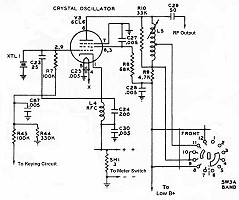
Click here for a higher resolution (larger) schematic.

Introduction:
Though the Johnson Viking Ranger has an internal VFO, it can also be crystal
controlled. A socket is provided for two crystals, and a simple flip of the
Crystal/VFO switch changes the Crystal Oscillator/Buffer stage into a crystal
oscillator. In the schematic diagrams on this page, it is assumed that the
Crystal/VFO switch is in the XT1 position.
Three frequency ranges are used for the crystals. For 160m crystals in the
1750kHz to 2000kHz range must be used. For 80m, either 1750kHz to 2000kHz or
3500kHz to 4000kHz crystals can be used. For 40m, either 3500kHz to 3650Hz or
7000kHz to 7300kHz can be used. For the remaining bands crystals beginning at
7000kHz should be used. Though crystals in the other frequency ranges might
work, spurious outputs may be larger if 7000kHz crystals are not used.
If the schematic below is compared to the
schematic for the VFO the two
circuits will be seen to be very similar. The primary differences are that the
crystal replaces the L/C tuned circuit of the VFO and the
grid coupling and cathode feedback capacitors have smaller values
than in the VFO circuit. The the crystal oscillator also has a
tuned output circuit rather than the simple RF choke
in the VFO oscillator. Otherwise, the circuits are very similar.
The crystal oscillator is a beautiful example of an electron coupled
oscillator. The AA8V 6CL6
transmitter uses a similar circuit as a complete transmitter. You can read
about the operation of an electron coupled oscillator in greater detail by
going to this link: Electron Coupled
Oscillator.
Crystal
Oscillator Circuit
Click On A Section of the Schematic
Below for Information on That Part of the Circuit:

| Grid Coupling Capacitor: When the circuit is oscillating the voltage developed across crystal is unequally divided across the grid coupling capacitor C23 and the cathode feedback capacitor C24 in inverse proportion to their capacitance. The HIGHER the capacitance, the SMALLER the voltage developed across the capacitor. Since the capacitance of the grid coupling capacitor is 25pf and the capacitance of the cathode feedback capacitor is 200pf, 89% of the voltage appears across the grid coupling capacitor and 11% appears across the cathode feedback capacitor. The portion that appears across the grid coupling capacitor C23 is applied across the grid and cathode of the 6CL6 tube, where it is amplified. |
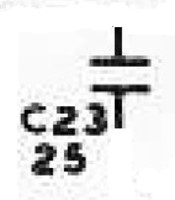 |
| Cathode Feedback Capacitor: The signal applied to the grid of the tube is amplified and part of the amplified signal is taken from the screen grid (not the plate) of the tube and is shunted to ground through the screen bypass capacitor. This signal must get back to the cathode of the tube, but it can't pass through the cathode RF choke, which blocks any RF. Instead, it travels from ground back through the cathode feedback capacitor C24 to the cathode of the tube. As it travels through the feedback capacitor, it causes a small voltage to appear across the capacitor. This voltage is in phase with the oscillation in the crystal circuit and tends to assist the oscillation, restoring any energy that was lost. The voltage across a capacitor is in inverse proportion to the capacitance of the capacitor. Because of the large size of the feedback capacitor compared to that of the grid coupling capacitor, a smaller voltage is developed across the capacitor. This minimizes the effect of the feedback on the oscillator, keeping the feedback to a minimum. This keeps the amplitude of crystal oscillation (and crystal current) as small as possible, minimizing any heating of the crystal caused by the oscillating current. Though the crystal is quite stable, excessive heating can cause a noticeable change in frequency (chirp). Very high crystal current can ruin the crystal. |
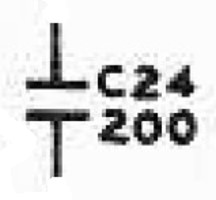 |
| Keying Resistors: Grid block keying is used in the Johnson Viking Ranger. While the key is up the keying circuit applies a negative voltage across resistors R45 and R44 which function as a voltage divider, and also isolate the oscillator somewhat from the output of the keying circuit. About 3/4 of the applied voltage is passed on through the grid leak resistor to the grid of the tube, shutting it off. When the key is pressed, the blocking voltage is removed and the circuit begins oscillating. |
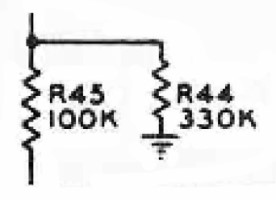 |
| 6CL6 Tube: In 1950, an important article in QST magazine, "Crystal-Controlled Oscillators, A Review of Modern Crystals, Circuits and Tubes" (QST, March 1950, C. Vernon Chambers, W1JEQ) addressed several points concerning crystal oscillators, including which tube to use. In that article, various electron-coupled circuits were tried along with a variety of tubes: the 6AG7, 6F6, 6V6GT, and 6L6. Among the many conclusions in the article, one came through loud and clear, which I quote here: "Of the four tubes tested the 6AG7 is by far the best from every standpoint." As a result of that article, virtually all crystal oscillator circuits in the ARRL handbook for the next 15 years featured or recommended the use of the 6AG7. The 6CL6 is the 9-pin miniature equivalent of the 6AG7, so it will give exactly the same performance as the 6AG7 in a smaller package. You can click here for a 6CL6 data sheet. |
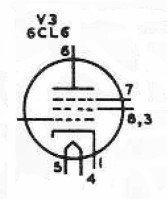
|
| Cathode RF Choke: Direct current must be allowed to flow to the tube cathode, but RF must be blocked so that it flows through the cathode feedback capacitor instead. This is done by connecting the cathode to ground through an RF choke, which blocks RF but passes DC. |
 |
| Cathode/Meter Bypass Capacitor: The cathode/meter bypass capacitor prevents any RF that may have escaped through the cathode RF choke from getting through to the front panel meter, causing erroneous readings. |
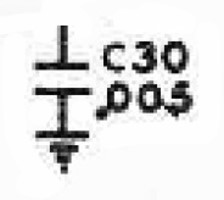 |
| Screen Bypass Capacitor: The screen grid of the tube serves as the plate of the oscillator in an electron coupled oscillator. Some of the RF amplified by the tube must get back to the resonant circuit to support oscillation. The screen bypass capacitor allows the RF on the screen grid to pass through to ground while preventing the screen DC supply from being short circuited. The RF eventually flows through the cathode feedback capacitor back to the cathode of the tube. When it flows through the cathode feedback capacitor, it provides the necessary feedback to keep the oscillator going. |
 |
| Output Tank Circuit: The output of V3 is fed to a tank circuit controlled by the band switch. The bandswitch switches in and out R9 and various portions of L5, the tank coil. Resistor R10 loads the tank coil and lowers the overall Q of the circuit. The effect is to select the proper output frequency without requiring an additional tuning control on the front of the transmitter. |
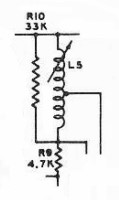 |
| Band Switch: The band switch shorts out various resistors and coil sections in the output tank circuit to select the correct output frequency from the oscillator and to keep the output as uniform as possible. |

|
| Plate Bypass Capacitor: The plate bypass capacitor grounds the bottom of the output tank circuit for RF while blocking the DC plate voltage on the tube. It also prevents any RF from reaching the low B+ supply. |
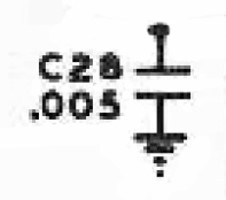 |
| Screen Dropping Resistor: The crystal oscillator is an example of an electron coupled oscillator. In such a circuit, the screen grid of the tube functions as the plate of the oscillator. The correct voltage for the screen of the tube is obtained by using a dropping resistor connected to the low B+ supply. The value of the resistor is chosen so that the screen voltage is correct when the tube is drawing normal screen current. |
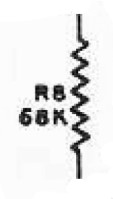 |
 Back to Dr.
Greg Latta's Electrical Engineering and Amateur Radio Pages
Back to Dr.
Greg Latta's Electrical Engineering and Amateur Radio Pages
 If you have any questions or
comments, you can send E-Mail to Dr. Greg Latta at
glatta@frostburg.edu
If you have any questions or
comments, you can send E-Mail to Dr. Greg Latta at
glatta@frostburg.edu